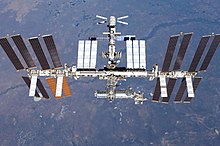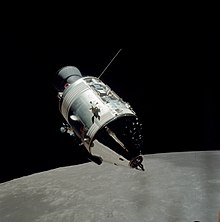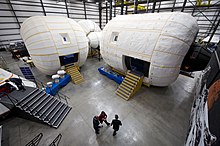|
List of crewed spacecraft
 This is a list of all crewed spacecraft types that have flown into space, including sub-orbital flights above 80 km, space stations that have been visited by at least one crew, and spacecraft currently planned to operate with crews in the future.[1] It does not contain spacecraft that have only flown un-crewed and have retired from service, even if they were designed for crewed flight, such as Buran, or crewed flights by spacecraft below 80 km. There is some debate concerning the height at which space is reached (the Karman Line): the Fédération Aéronautique Internationale (FAI) recognizes 100 km, while NASA and the USAF recognize this as 50 miles (approx 80 km).[2] Since the first crewed spaceflight of Vostok 1 in 1961 there have been 13 types of spacecraft that have made crewed flights into space – nine American, three Russian, and one Chinese. There are currently five operational crewed spacecraft, which form the first part of the list below; the eight retired spacecraft types are listed in the next section; and crewed spacecraft currently in development are listed last. Space stations are listed beneath each appropriate section, dates of operation reflect when the first and last crews visited, not when they were launched and deorbited. There are currently two space stations in orbit around Earth, the International Space Station and the Chinese Tiangong space station. Crewed spacecraft are designed to support human life for the human spaceflight portion of the mission. Spacecraft for human spaceflight must have a human-rating certification as fit for purpose. Crewed spacecraft must have a pressurized, breathable atmosphere (usually between 345 mbar and 1 bar (1 atmosphere)) and be temperature-regulated (usually 20 to 24 °C (68 to 75 °F)). Crewed spacecraft include space capsules, spaceplanes, and space stations. Currently operational crewed spacecraftSoyuz (1967) Russian three person Earth orbital spacecraft;[3] Early versions were operated by the Soviet Union and later versions by Russia after 1991. Soyuz has completed over 150 crewed spaceflights, including two emergency sub-orbital flights: Soyuz 18a and Soyuz MS-10. There have been two spacecraft losses resulting in the deaths of four cosmonauts, Soyuz 1 and Soyuz 11. Soyuz is the only spacecraft to have successfully saved the lives of a crew using the rocket launch escape system, when in 1983 Soyuz T-10-1 exploded on the launchpad. This spacecraft type has flown into space more times than any other spacecraft.[4] Shenzhou (2003)Chinese three-person Earth orbital spacecraft. Shenzhou is China's first crewed spacecraft. On 15 October 2003, Yang Liwei was carried into space by Shenzhou 5 becoming China's first Taikonaut.[5] The spacecraft has gone on to fly crews to China's Tiangong-1 and Tiangong-2 space labs. Since Jun 2021, Shenzhou has been used as the vehicle to send crews to China's new modular Tiangong space station and back.[6] As of December 2023, Shenzhou has made 12 successful crewed spaceflights. Crew Dragon (2020) United States four-person (initially seven) Earth orbital spacecraft designed by SpaceX to transport astronauts to the International Space Station under the NASA Commercial Crew Contract (CCDev). As of March 2024, Crew Dragon has made 13 crewed spaceflights. The first crewed flight, Crew Dragon Demo-2, launched on 30 May 2020 and returned to Earth on 2 August 2020. This was the first time an American spacecraft had sent astronauts to orbit since the final Space Shuttle flight in July 2011.[7] The first operational flight of the Crew Dragon launched on 15 November 2020 with SpaceX Crew-1. New Shepard (2021) New Shepard is a six-person capsule for suborbital space tourism in the United States. It is launched by a reusable booster and can fly with or without crew. Uncrewed flights started in 2015. The first crewed test flight flew on 20 July 2021.[8] As of December 2023 there have been 24 flights, including six crewed flights carrying a total of 32 passengers into space. Starliner (2024) United States five-person (initially seven) Earth orbital spacecraft designed to transport astronauts to the International Space Station under the NASA Commercial Crew Program. Following several technical problems on the first uncrewed test flight in December 2019, a second uncrewed test flight launched in May 2022. The following crewed flight test (CFT) launched in June 2024; after experiencing thruster issues, Starliner landed uncrewed, with the astronauts slated to return on Crew Dragon.[9][10] Currently operational space stationsInternational Space Station (ISS) (1998) Multinational low Earth orbit modular space station. The International Space Station is a joint project among five participating space agencies: NASA, Roscosmos, JAXA, European Space Agency (ESA), and Canadian Space Agency (CSA).[11] Following the uncrewed initial assembly from 1998 to 2000, it has been continuously crewed since November 2000. As of 4 March 2024, ISS has been visited by 111 crewed spacecraft (68 Soyuz, 35 Space Shuttle, and 9 Crew Dragon). The ISS is the largest space station yet constructed. It is planned to operate until 2028, with a possible extension to 2030.[12] Tiangong Space Station (2021)Chinese low Earth orbit modular space station. The Tianhe core module was launched on 29 April 2021. The first crewed flight Shenzhou 12 with 3 astronauts arrived at the station in June 2021. The space station has three modules: the Tianhe core module, and two Laboratory Cabin Modules. The Wentian module docked with the station on 24 July 2022, and the Mengtian module docked on 31 October 2022. Former crewed spacecraftVostok (1961–1963) Soviet single-person Earth orbital spacecraft 6 flights.[13] On 12 April 1961 Vostok 1 carried the first human into space, Cosmonaut Yuri Gagarin.[14] On 16 June 1963, Vostok 6 carried the first woman into space, Cosmonaut Valentina Tereshkova.[15] Mercury (1961–1963)United States single-person Earth orbital spacecraft 6 flights (including 2 sub-orbital).[16] Mercury was the United States first crewed spacecraft. On 5 May 1961 Mercury-Redstone 3 carried the first American, Alan Shepard, into space on a sub-orbital flight. On 20 February 1962, Mercury-Atlas 6 carried the first American, John Glenn, into Earth orbit.[17] X-15 (1962–1968) United States single seat, air-launched sub-orbital spaceplane; two X-15 flights above the 100 km Kármán line occurred in 1963, an additional 11 flights between 1962 and 1968 reached altitudes between 80 and 100 km which were recognized as spaceflights by U.S. authorities.[18] Voskhod (1964–1965)Soviet three person Vostok derivative made 2 flights.[19] On 18 March 1965, Alexei Leonov performed the first spacewalk in history, from Voskhod 2.[20] Gemini (1965–1966)United States two person Earth orbital spacecraft which made 10 flights.[21] On 3 June 1965, Ed White made America's first spacewalk during Gemini 4.[22] Apollo (1968–1975) United States three-person lunar-capable spacecraft. 15 flights; including nine lunar missions (with six lunar landings). It was the Apollo spacecraft that enabled America to win the Space Race. In December 1968, Apollo 8 was the first crewed spacecraft to orbit the Moon. On 21 July 1969, Neil Armstrong, the Commander of Apollo 11, and Buzz Aldrin became the first humans to walk on the Moon.[23] The Apollo Spacecraft comprised:
Space Shuttle (1981–2011) United States eight person Earth orbital spacecraft; first orbit-capable spaceplane; first reusable orbital spacecraft. Largest cargo capacity to orbit at the time. 133 spaceflights were made in six shuttles; Enterprise, Columbia, Challenger, Discovery, Atlantis, and Endeavour. SpaceShipOne (2004)United States privately-developed single pilot, air-launched sub-orbital spaceplane; three flights above the Kármán line occurred in 2004. SpaceShipTwo (2018)United States eight person air-launched sub-orbital space plane operated by Virgin Galactic aimed at the space tourism market. On 31 October 2014 during a test flight, VSS Enterprise, the first SpaceShipTwo craft, broke up in flight and crashed in the Mojave Desert.[27][28][29][30] One pilot was killed.[31][32] The second SpaceShipTwo craft, VSS Unity, was completed in 2016 and used until its retirement in 2024.[33] On 13 December 2018, SpaceShipTwo flew to an altitude of 82.7 km, which is recognized as space by the FAA, NASA, and the USAF (although not the Fédération Aéronautique Internationale).[34] This was the first time an American spacecraft had sent astronauts to space since the final Space Shuttle flight in 2011. On 11 July 2021 a fourth test flight was made above 80 km with six crew aboard, including the company owner Richard Branson.[35] As of January 2024, SpaceShipTwo has made 12 successful crewed spaceflights. The last flight of VSS Unity took place on 8 June 2024, marking the spacecraft's retirement. Former space stationsSalyut (1971–1986)Soviet/Russian low Earth orbit space stations.[36] Salyut 1 (1 crew 1971), Salyut 4 (2 crews 1975), Salyut 6 (6 crews 1977–1981), and Salyut 7 (12 crews 1982–1986). All now de-orbited.[37] Almaz (1974–1977)Soviet military reconnaissance low Earth orbit space stations. Badged as Salyut 3 (1 crew 1974), and Salyut 5 (2 crews 1976–1977), as disinformation. Both now deorbited.[37] Skylab (1973–1974)United States low Earth orbit space station. First United States space station. Visited by 3 crews 1973–1974. It deorbited in 1979.[38] Mir (1986–2000)Soviet/Russian low Earth orbit modular space station. The first modular space station in history. Twenty-eight crews 1986–2000. Mir was visited by 29 Soyuz and 7 Space Shuttle missions. Mir was deorbited in 2001.[39] Tiangong program (2012–2016)Chinese low Earth orbit space laboratories. Tiangong 1 was China's first space station; launched in 2011, visited by two crews 2012–2013, deorbited in 2018. Tiangong 2 was launched in 2016, visited by one crew in 2016, deorbited in 2019. Both vehicles were single-module laboratories, precursors to the modular Tiangong space station, which has modules derived from Tiangong 1 and 2. Crewed spacecraft in developmentOrionA spacecraft capable of lunar missions with a crew of four, planned to be used as part of NASA's Artemis program. Consisting of two components – a Crew Module (CM) manufactured by Lockheed Martin, and a European Service Module (ESM) manufactured by Airbus Defence and Space – the spacecraft are designed to support crewed exploration beyond low Earth orbit. Orion is equipped with solar power, an automated docking system, and glass cockpit interfaces modeled after those used in the Boeing 787 Dreamliner, and can support a crew of six in low Earth orbit and a crew of four in lunar orbit, up to 21 days undocked and up to six months docked. A single AJ10 engine provides the spacecraft's primary propulsion, while eight R-4D-11 engines and six pods of custom reaction control system (RCS) engines developed by Airbus provide the spacecraft's secondary propulsion. Although compatible with other launch vehicles, Orion is primarily designed to launch atop the Space Launch System (SLS) rocket. The first mission on that flew a fully configured Orion spacecraft and service module was Artemis I. This flight, however, was not a crewed mission and served the purpose of testing the systems of the spacecraft in the environment it was designed for. The first crewed mission Artemis II is planned for 2024 and will slingshot around the Moon. The following crewed Artemis III flight is planned for 2025 and will be a lunar landing mission. StarshipPlanned to be a fully reusable interplanetary spacecraft capable of carrying 100 passengers or cargo. Primarily designed for Mars missions it is to be capable of landing on all rocky planets or moons in the Solar System except Venus.[40] For Earth launches Starship will need a two-stage configuration with the addition of a powerful first stage booster called Super-Heavy. Flights from all other planetary bodies will not require a first stage booster. Starship will require refuelling in Earth orbit to enable it to reach other Solar System destinations.[41][42] Uncrewed test flights commenced in 2020 from Boca Chica, Texas. A custom crewed lunar version of Starship—Starship HLS—was selected in 2021 from three companies that developed design proposals for NASA's Human Landing System for NASA's Artemis program, with a view to land one uncrewed mission plus one crewed mission on the Moon no earlier than 2025.[43][44] SpaceX plans at least six variants of Starship, two of them intended to carry crew: Cargo flights, crewed flights (except HLS), a fuel depot,[45] a tanker version, expendable starships, and HLS. GaganyaanA three-person Earth orbital spacecraft intended to be the first crewed spacecraft of the Indian Human Spaceflight Programme. Gaganyaan will be capable of operating at low Earth orbit for up to seven days. The upgraded version will be equipped with rendezvous and docking capabilities. Its first crewed flight is planned for March 2025, and four Indian astronauts have begun flight training in Russia.[46] MengzhouThe Mengzhou spacecraft, developed by the China Aerospace Science and Technology Corp. (CASC) is a six-person, partially reusable lunar-capable spacecraft, aiming to succeed the Shenzhou. An uncrewed test flight took place on 5 May 2020, with a crewed flight to low earth orbit possible by 2027 using a two-stage variant of the under-development Long March 10 rocket.[47] Lunar missions by the new spacecraft are expected in the 2030s with an initial lunar mission possible by 2030.[47][48] A new Chinese crewed lunar lander called Lanyue is also currently under-development by the China Academy of Space Technology.[47] Dream ChaserUnited States seven-person Earth orbital space plane.[49] An uncrewed cargo version is scheduled to fly in space in 2025, with a crewed version to eventually follow.[50] OrelRussian four-person lunar-capable spacecraft to enable the retirement of Soyuz. The first uncrewed and crewed flight is planned for 2028.[51] [52] Crewed spacecraft (planned)
Space stations in development
Cancelled crewed spacecraft and space stations
See also
ReferencesCitations
Sources
|
